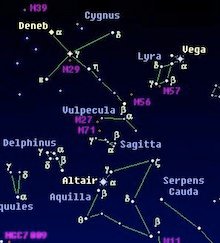Another month named after a Roman emperor, Augustus, and in order that he would not be considered less than Julius Caesar, he too was conceded 31 days, when the custom was to alternate the numbers.
Our zodiacal constellation of today is CAPRICORN (ch.15), one of the smaller and less brilliant ones. During the night of the 1st/2nd of August, at one o´clock in the morning, it draws a triangle in the area comprised between south-west and south. Its points are DENEB ALGEDI (the tail of the goat), at one hand above Guijo de Coria; OMEGA-CAP at a little less than a hand to the right of Morcillo; a little more to the right, ALGEDI (the goat), which is actually double, at almost two hands, and, very near to and below it, is DABIH (the butchers’ lucky one).
If we continue to look higher, in the Milky Way we shall find the brilliant ALTAIR, (eagle in flight), of the  constellation AQUILA (ch.6), at almost three hands above Puebla de Argeme. It is surrounded by another two stars, forming a wing, a little to the north of TARZED, and a little to the south of ALSHAIN, whose names come from the Persian “the star of the falcon”.
constellation AQUILA (ch.6), at almost three hands above Puebla de Argeme. It is surrounded by another two stars, forming a wing, a little to the north of TARZED, and a little to the south of ALSHAIN, whose names come from the Persian “the star of the falcon”.
To its left and at the same height, but above Guijo de Galisteo, we are able to see, near the Milky Way, a pretty diamond of four stars, which are the head of DELPHINUS (ch.15) rising out of the water. They are also known by the name of JACOB’S COFFIN.
Let us continue to raise our eyes and, on entering the Milky Way, we shall find the most precious NORTHERN CROSS,  which is the structure and wings of CYGNUS (ch.6). It is formed by DENEB (the tail), at approximately three and a half hands over Torrecilla de Los Ángeles; SADR (the breast), at almost four hands above Villanueva de la Sierra; GIENAH (the wing) at a little more than three hands above Pozuelo de Zarzón; DELTA-CYG, at four hands a little to the right of Robledillo de Gata, and, finally, ALBIREO (its name referring to a type of plant), at three and a half hands over Calzadilla.
which is the structure and wings of CYGNUS (ch.6). It is formed by DENEB (the tail), at approximately three and a half hands over Torrecilla de Los Ángeles; SADR (the breast), at almost four hands above Villanueva de la Sierra; GIENAH (the wing) at a little more than three hands above Pozuelo de Zarzón; DELTA-CYG, at four hands a little to the right of Robledillo de Gata, and, finally, ALBIREO (its name referring to a type of plant), at three and a half hands over Calzadilla.
Between Albireo and Altair one can see four stars in a row of the constellation SAGITTA (ch.25).
Along the edge of the Milky Way, in the opposite direction to the Dolphin, in the constellation of LYRA (ch.6), shines the most brilliant star of the firmament, VEGA (eagle of the desert), almost at the zenith (ch.3).
But the very special gift of August are the PERSEIDAS, (ch. 9), a burning shower of pieces of the comet  Swift-Tuttle, also known as SAN LORENZO’S TEARS. Even though they can be observed during almost the whole of the month, one of the best times is between 4 and 5 in the morning of the 12th and 13th. Its radiant is to the north of the constellation of PERSEO (ch. 9), which at that particular time is at just over two hands above the area between Cadalso and Hernán Pérez.
Swift-Tuttle, also known as SAN LORENZO’S TEARS. Even though they can be observed during almost the whole of the month, one of the best times is between 4 and 5 in the morning of the 12th and 13th. Its radiant is to the north of the constellation of PERSEO (ch. 9), which at that particular time is at just over two hands above the area between Cadalso and Hernán Pérez.
May luck be with us and may life treat us with gentleness!








